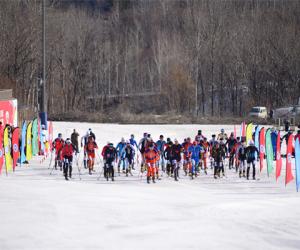Lhasa may have been the most important market in Tibet for Pu’er tea, but it was also a transit point for Chinese brick tea destined for points further west within Tibet – notably the major towns of Shigatse and Gyantse, now respectively Tibet’s second and fourth largest urban centres – as well as for Bhutan, Nepal, Sikkim and India.
 Tibetan Nomads, Joespeh Rock, 1925
Tibetan Nomads, Joespeh Rock, 1925
Today, with India established as the world’s second largest tea producer after China, it may seem strange that, as recently as the mid-19th century, tea was exported from China to India along the ancient Tea-Horse Road via Tibet. Yet such was indeed the case. The British established a sanatorium at Darjeeling in 1835 by agreement with the Chogyal (hereditary ruler) of Sikkim, and in 1841 Dr Arthur Campbell, as Superintendent of this newest addition to the territories of the British Raj, planted ‘China tea seeds’ in the garden of his official residence at Beechwood. The tea seedlings grew well, and by the second half of the 19th century British-owned tea estates were established throughout the area, as well as spreading into Assam.
Before this time, according to a ‘Darjeeling Tea History’ published by the Darjeeling News ‘The native tribes in the Himalayas drank tea that was imported from Tibet, which was transported thousands of kilometres. It was a coarse, harsh, black tea, which arrived in blocks or bricks of 2.7 kg, or 3.1 kg weight, and 20 cm in length and 10 cm deep, and was sewn up in raw kidskins, where the tea appeared through the stitches at the sides. It costed [sic] two shillings a pound’. This tea, known locally as ‘Thibet brick’, was boiled in a large iron pot ‘together with a little salt, butter and parched barley meal’. Next ‘each partaker of the tea produced his or her own wooden teacup from the bosom folds of their capacious clothes, and when the cup had been frequently filled, and as rapidly emptied, it was licked clean by the owner and replaced whence it was taken. Everyone was supposed to carry a teacup about the person and ten or twelve cups full was considered no extraordinary drink for a tea-loving Bhotia’ (Sikkimese). Clearly, the Sikkimese and Bengalis traditionally purchased and drank Pu’er tea imported from Yunnan and Sichuan.
In fact, before the British annexed Darjeeling to India in 1835 and made the Choygal of Sikkim into a British puppet, Sikkim had been the main gateway by which Chinese tea had reached Assam and Bengal. Tea caravans set out from Lhasa on a dizzying extension of the Tea-Horse Road that led south over the Kampa La pass (4,794m), through Nagarze, across the Karo La pass (5,045m) west to Gyantse, and then south again across Tang La pass (5,060m) to Pagri and to Yadong – the latter being the last town in Tibet before the difficult Nathu La Pass (4,310m) marking the frontier with Sikkim.
This fascinating – and once very profitable – extension of the Tea-Horse Road from distant Ya’an and Xishuangbanna led the muleteers past the turquoise waters of Yamdrok Tso, the third largest lake in Tibet, through the village of Nagarze, to Gyantse, remarkable for its old Dzong or fortress, as well as for the spectacular Kumbum Chorten (’10,000 images stupa’), rising in nine levels from the grounds of Pelkor Chode Monastery to the northwest of town. With 108 chapels and seemingly countless murals, this vast chorten, crowned with a gilded dome and umbrella, offers spectacular views across the old wool- and tea-trading centre of Gyantse to the south.
Beyond Gyantse, the old Tea-Horse Road to India – now Highway 204 – climbs through spectacular, sparsely-inhabited terrain, passing the villages of Kangmar, Gala and Guru (all currently with fewer than 500 inhabitants) before reaching Pagri – at 4,700m (15,000 ft) one of the highest and coldest settlements anywhere in the world – and finally Yadong, the last town in China before Sikkim, situated in the mouth of the Chumbi Valley by the frontiers with both India and Bhutan. Here the muleteers would have been able to pause before crossing into Sikkim, enjoying comforts both spiritual – Yadong is home to Donggar and Garju Monasteries – and mundane, since the border town has long been known for its hot springs, tasty ‘Yadong fish’ and intoxicating barley wine. Web image Kanchengjunga from Gangtok
Immediately after Yadong the old caravan road leads over the Nathu La Pass, climbing to 4,310m before crossing the frontier and descending, initially through harsh alpine terrain and later through lush rhododendron forests, to the Sikkimese capital of Gangtok (1,437m), until 1975 seat of the hereditary Chogyal of Sikkim, and also, following the construction of Enchey Monastery in 1840, an important Mahayana Buddhist pilgrimage site.
Gangtok, a tranquil and delightful town set on a ridge facing the snowy peak of Kanchenjunga, at 8,598m the world’s third highest mountain, really marks the end of the old Tea-Horse Road from China to India. From here it’s a short and relatively easy journey, via the villages of Singtam and Rangpo, to the hill station of Kalimpong, the first town in West Bengal, and then on to Darjeeling, another famous hill station dating from British times which, today, is internationally famous for its many excellent tea estates.

 Tibetan Nomads, Joespeh Rock, 1925
Tibetan Nomads, Joespeh Rock, 1925




